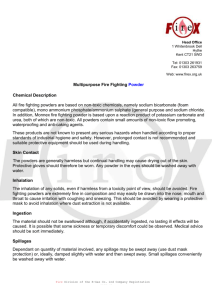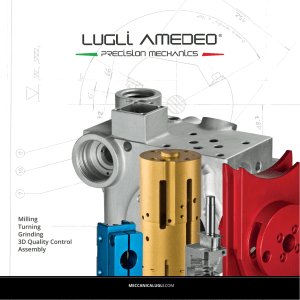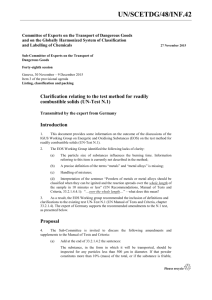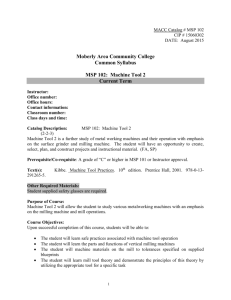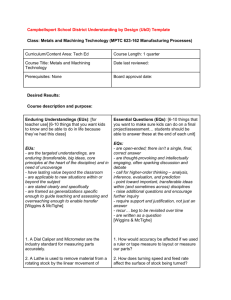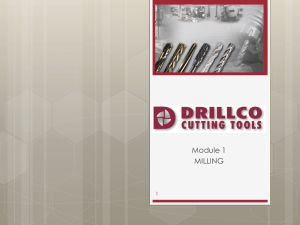Title Goes Here
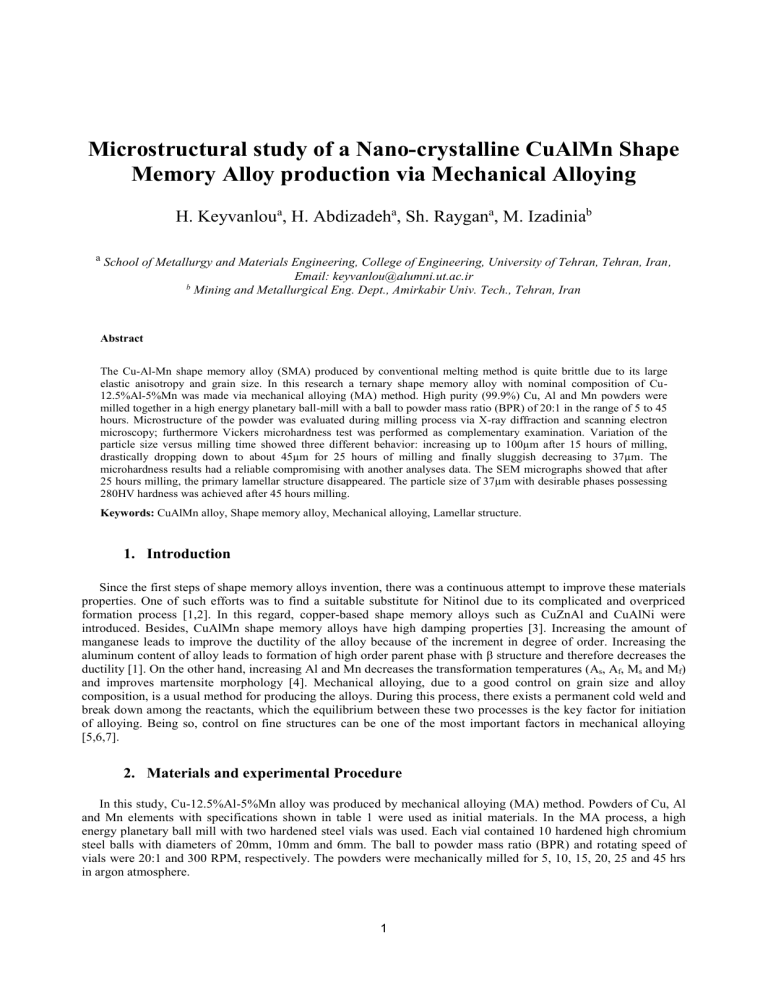
Microstructural study of a Nano-crystalline CuAlMn Shape
Memory Alloy production via Mechanical Alloying
H. Keyvanlou
a
, H. Abdizadeh
a
, Sh. Raygan
a
, M. Izadinia
b a
School of Metallurgy and Materials Engineering, College of Engineering, University of Tehran, Tehran, Iran,
Email: keyvanlou@alumni.ut.ac.ir
b Mining and Metallurgical Eng. Dept., Amirkabir Univ. Tech., Tehran, Iran
Abstract
The Cu-Al-Mn shape memory alloy (SMA) produced by conventional melting method is quite brittle due to its large elastic anisotropy and grain size. In this research a ternary shape memory alloy with nominal composition of Cu-
12.5%Al-5%Mn was made via mechanical alloying (MA) method. High purity (99.9%) Cu, Al and Mn powders were milled together in a high energy planetary ball-mill with a ball to powder mass ratio (BPR) of 20:1 in the range of 5 to 45 hours. Microstructure of the powder was evaluated during milling process via X-ray diffraction and scanning electron microscopy; furthermore Vickers microhardness test was performed as complementary examination. Variation of the particle size versus milling time showed three different behavior: increasing up to 100µm after 15 hours of milling, drastically dropping down to about 45µm for 25 hours of milling and finally sluggish decreasing to 37µm. The microhardness results had a reliable compromising with another analyses data. The SEM micrographs showed that after
25 hours milling, the primary lamellar structure disappeared. The particle size of 37µm with desirable phases possessing
280HV hardness was achieved after 45 hours milling.
Keywords: CuAlMn alloy, Shape memory alloy, Mechanical alloying, Lamellar structure.
1.
Introduction
Since the first steps of shape memory alloys invention, there was a continuous attempt to improve these materials properties. One of such efforts was to find a suitable substitute for Nitinol due to its complicated and overpriced formation process [1,2]. In this regard, copper-based shape memory alloys such as CuZnAl and CuAlNi were introduced. Besides, CuAlMn shape memory alloys have high damping properties [3]. Increasing the amount of manganese leads to improve the ductility of the alloy because of the increment in degree of order. Increasing the aluminum content of alloy leads to formation of high order parent phase with β structure and therefore decreases the ductility [1]. On the other hand, increasing Al and Mn decreases the transformation temperatures (A s
, A f
, M s
and M f
) and improves martensite morphology [4]. Mechanical alloying, due to a good control on grain size and alloy composition, is a usual method for producing the alloys. During this process, there exists a permanent cold weld and break down among the reactants, which the equilibrium between these two processes is the key factor for initiation of alloying. Being so, control on fine structures can be one of the most important factors in mechanical alloying
[5,6,7].
2.
Materials and experimental Procedure
In this study, Cu-12.5%Al-5%Mn alloy was produced by mechanical alloying (MA) method. Powders of Cu, Al and Mn elements with specifications shown in table 1 were used as initial materials. In the MA process, a high energy planetary ball mill with two hardened steel vials was used. Each vial contained 10 hardened high chromium steel balls with diameters of 20mm, 10mm and 6mm. The ball to powder mass ratio (BPR) and rotating speed of vials were 20:1 and 300 RPM, respectively. The powders were mechanically milled for 5, 10, 15, 20, 25 and 45 hrs in argon atmosphere.
1
Particle size(µm)
Purity (%)
TABLE (1) . The specifications of elemental powders
Cu powder Al powder
<20
99.9
<20
99.9
Mn powder
<63
99.9
X-ray diffraction (XRD) (Philips Xpert Pro) at ambient temperature with Cu k
α
radiation (λ=0.154056 nm) and scanning electron microscopy (SEM) (CAM SCAN MV2300) were used in order to characterize the milled powders.
Vickers hardness of the powders were calculated utilizing a 2 N force and for dwell time of 15 seconds.
3.
Results and Discussions
3.1. XRD analysis
XRD patterns of milled powders at different times are shown in Figure 1. It can be seen that the peaks of aluminum and manganese vanish by increasing the milling time due to the process of solution of these elements in the copper matrix. It can also be observed that increasing milling time shift the copper peaks to smaller angles as a result of solution of Al and Mn in the lattice of copper and increasing the lattice parameter. Another consequence that can be observed from this figure is that increasing the milling time results in an increase in the main peak width i.e. decrease in crystallite size. Amorphization of the …. phase can be seen in 25 hour milled powder. On the other hand, a new peak arises in 45 hours milled powder, which is related to the production of the reaction.
The crystallite size of powder was calculated by the modified Scherrer equation according to the equation 1:
β=ηtanθ + 0.9λ/Dcosθ
(1
Where β is the Full-Width Half-Maximum (FWHM) in radian, λ is wavelength of X-rays, D is the diameter of
Crystallite, η is the lattice strain and θ is the angle corresponding to the peak. Figure 2 shows the graph for the crystallite and lattice strains for the milled powders, which were plotted with respect to eq.1 and using Jade5.
Increasing the milling time result in a decrease in crystallite size to 26nm and an increase in lattice strain to 0.89%.
FIGURE 1 . XRD patterns of milled powders.
2
FIGURE 2. Crystallite size and lattice strain of milled powders.
3.2. Morphology of powders during milling
SEM micrographs of milled powders and particles average size are shown in Figure 3 and Figure 4, respectively.
Increasing of milling time up to 15 hours will increase the size of particles (Fig. 3a-c). During milling process two important phenomena take place simultaneously: fracturing of the particles and welding the particles together. Due to softness of copper-based alloys, the welding process dominates the fracturing process during first step of milling and therefore the size of particles increases with increasing milling time. After 15 hours of milling, due to work hardening and subsequent embrittlement of powder particles fracturing over run the welding, thus the particle size of all samples will tend to decrease down to average size of 36µm. As a rule of thumb, increasing milling time result in more brittle powders and it becomes finer as well, so there is a finer distribution throughout the whole.
FIGURE 3 . SEM micrographs of milled powders: a) 5 hrs, b) 10 hrs, c)15 hrs, d) 20 hrs, e) 25 hrs, f) 45 hrs milled.
3
FIGURE 4.
Particles average size.
Figure 5 shows morphology of milled powders. In the beginning of alloying process and for only 5 hours of milling, the dominant phenomena of the reaction is flattening and cold welding, which leads in generation of flaky shape lumps in powder, but a low amount of powder remains in its initial form. Increasing milling time to 10 hours, due to the softness of the reactants leads to bigger lumps. Fractions of powders, which till now have not participated in the reaction, react in milling process now and the flaky shaped structure can be observed throughout the whole powders. As the milling time is increased to 15 hours, some alterations in the structure can be observed.
As it can be seen in Fig. 5c, flakes which are located in lamellar structures, without expanding in size, tend to form a coherent structure with similar neighboring flakes and lamellar structure alter into uniform shape. This process is called "the transition stage" and it is the commencement of the mechanical alloying. As milling time is further extended to 20 hours, flaky shape structures can now be observed, but besides them, smaller grains due to fracturing of lumps are present. These particles do not have the flaky shape and alloying can be deduced from their form. This step of mechanical alloying is the beginning of the fracturing of particles, because of the severe plastic deformations.
Further milling up to 25 hours, causes a decrease in the amount of flaky shape layers (Fig. 5e). If milling time increases to 45 hours, smooth and fine structure can be obtained because of repetitive fractures.
In one word, it can be deduced that, the main part of the plastic deformation energy in first 15 hours will be spent on flattening, cold welding and fining of lamellar microstructure. In its pursuit comes the severe plastic deformation and stacking of crystal defects. As a result of crystal defects, nano-crystallites will present in micro-size particles.
4
FIGURE 5 . Morphology of milled powders: a) 5 hrs, b) 10 hrs, c)15 hrs, d) 20 hrs, e) 25 hrs, f) 45 hrs milled.
3.3. Microhardness of powders
Figure 6 shows the microhardness of milled powders for different times of milling.
FIGURE 6.
Microhardness of milled powders.
5
As it can be seen in Fig. 6, there are three different regions in Microhardness-Milling time plot. First region
(milling times less than 15 hours) has a slow rate increase in hardness by increasing milling time. The slow slope can be related to the presence of aggregate in powders. High fraction of powders does not undergo work hardening in this region. Milling powders more than 15 hours results in increasing the hardening rate of powders. Hardness reached 298 V after 25 hours milling. Finally there is a saturation region. There is no more increase in hardness by increasing milling time. Saturation in hardness could happen as a result of increase in vials temperature. Thus there is a competition between annealing and work hardening in this region.
4.
Conclusions
1.
Production of CuAlMn alloy begins after 25 hrs of milling.
2.
Increasing milling time up to 15 hours increase the particle size due to copper softness. After 15 hours particle size decrease as a result of work hardening and subsequent embrittlement of milled powders.
3.
By increasing milling time, flaky shape microstructure converts to uniform structure that implies accomplishment of mechanical alloying.
4.
On the basis of the evolution of particle morphology, four different stages can be identified during milling:
(a) flattening and cold welding of elemental powder particles to form a porous aggregate of particles; (b) plastic deformation of these small aggregates leading to the formation of particles having lamellar structure;
(c) severe plastic deformation leading to the formation of elongated flaky particles; and (d) fragmentation to smaller size flaky powder particles.
5.
References
[1]
[2]
[3]
[4]
[5]
[6]
[7]
U.S. Mallik and V. Sampath,” Influence of quaternary alloying additions on transformation temperatures and shape memory properties of Cu–Al–Mn shape memory alloy”, Journal of alloys and compounds, Vol. 469, pp. 156–163, Apr.
2009.
Y. Zheng and C. Li,” Cu–Al–Mn alloy with shape memory effect at low temperature”, Journal of Alloys and
Compounds, Vol. 441, pp. 317–322, Dec. 2007.
D.C. Lagoudas,” Shape Memory Alloys Modeling and Engineering Applications”, Texas: Springer, pp. 26-30, 2007.
S. Zhang, L. Lu and M.O. Lai,” Cu-based shape memory powder preparation using the mechanical alloying technique”,
Materials Science and Engineering, A, Vol. 171, pp. 257-262, Nov. 1997 .
S.M.Tang, C.Y. Chung and WG. Liu,” Preparation of Cu-AI-Ni-based Shape Memory Alloys by Mechanical Alloying and Powder Metallurgy Method”, Journal of Materials Processing Technology, Vol. 63, pp. 307-312, Feb. 1997.
Z. Xiao, Z. Li, M. Fang, M. Luo, S. Gong, and N. Tang, “Structure evolution of Cu-based shape memory powder during mechanical alloying,” Transactions of Nonferrous Metals Society of China, vol. 17, no. 6, pp. 1422-1427, Dec.
2007.
Z. Li, Z.Y. Pan, N. Tang, Y.B. Jiang, N. Liu, M. Fang, and F. Zheng “Cu-Al-Ni-Mn shape memory alloy processed by mechanical alloying and powder metallurgy,” Materials Science and Engineering: A, vol. 417, no. 1-2, pp. 225-229,
Feb. 2006.
6

